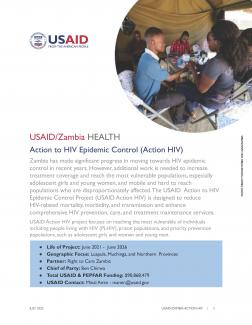Zambia has made significant progress in moving towards HIV epidemic control in recent years. However, additional work is needed to increase treatment coverage and reach the most vulnerable populations, especially adolescent girls and young women, and mobile and hard to reach populations who are disproportionately affected. The USAID Action to HIV Epidemic Control Project (USAID Action HIV) is designed to reduce HIV-related mortality, morbidity, and transmission and enhance comprehensive HIV prevention, care, and treatment maintenance services.
USAID Action HIV project focuses on reaching the most vulnerable of individuals including people living with HIV (PLHIV), prison populations, and priority prevention populations, such as adolescent girls and women and young men.
|
Over the past decade, Zambia has made notable advances towards managing its generalized HIV epidemic with over 1 million of the approximately 1.2 million HIV positive individuals on HIV treatment. Approximately 92 percent of those individuals have viral load suppression. Despite this progress, gaps in services remain, especially for key populations including young girls, young men, and pediatrics (children under 15). In order to achieve HIV epidemic control, Zambia must reach the critical target of 95 percent treatment coverage and provide high-quality services.
USAID Action HIV aims to reduce HIV mortality, morbidity, and transmission by achieving the joint United Nations Programme on HIV and AIDS (UNAIDS) and the U.S. President’s Emergency Plan for AIDS Relief (PEPFAR) goal of 95/95/95 HIV treatment coverage, meaning 95 percent of people know their HIV status, 95 percent of people who are HIV positive are on treatment, and 95 percent of people on treatment are virally suppressed. Concurrently, the project aims to provide comprehensive HIV prevention, care, and treatment maintenance services in Zambia’s Luapula, Muchinga, and Northern provinces. To achieve this, USAID Action HIV strengthens systems and provides direct service delivery at provincial, district, facility, and community level, with high HIV burden districts prioritized to achieve maximum impact. Technical assistance is tailored to each site. To deliver a comprehensive approach, USAID Action HIV targets the general population, again, with a particular focus placed on reaching adolescent girls and young women and young men.
Biomedical prevention strategies including voluntary medical male circumcision, pre-exposure prophylaxis, and cervical cancer screening and treatment are employed to also reach those at risk, identify new infections early, initiate efficacious treatment regimes on time, and retain those on treatment.
The project works to achieve and maintain HIV epidemic control through the following nine objectives:
- Ensure access to comprehensive HIV prevention interventions;
- Initiate 95 percent of those who tested positive on antiretroviral therapy (ART)
- Ensure that 95 percent of those on ART are virally suppressed;
- Reach 90 percent of eligible HIV positive adults and children with nutrition assessment; counseling, and support, and integrated voluntary family planning services at 95% of HIV service delivery points;
- Provide cervical cancer screening services for women living with HIV at HIV service delivery locations;
- Provide tuberculosis preventive treatment;
- Strengthen monitoring and evaluation capacity at the facility, district, and provincial levels for improved program management;
- Strengthen facility-level commodity management to mitigate the risk of stock outs; and,
- Strengthen the public financial management systems of the Ministry of Health and Ministry of Finance to enable the efficient use of direct government-to-government funds from USAID.
Expected Results
USAID Action HIV is expected to achieve and maintain HIV epidemic control through the provision of high-quality services and a biomedical prevention package of care. Overall the project aims to achieve:
- Increased access to comprehensive HIV prevention interventions;
- Achievement of the global 95/95/95 goals;
- 95 percent of HIV service delivery points reach 90 percent of eligible HIV positive adults and children with integrated nutrition support and family planning services;
- Increased provision of cervical cancer screening services and tuberculosis preventive treatment; and,
- Strengthened systems and capacity at facility, district, and provincial levels for monitoring and evaluation, commodity management, and public financial management.

